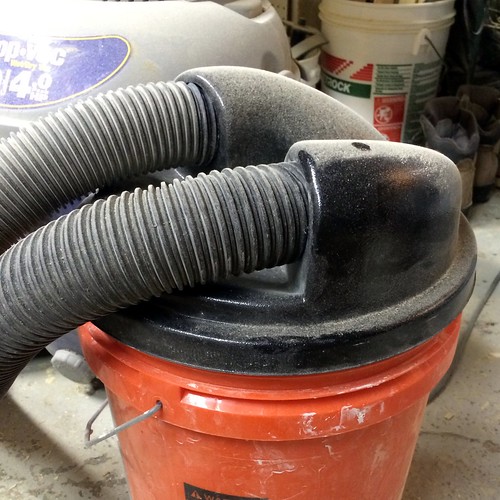Dust collection is easily one of the single biggest challenge when keeping an avid DIYer's shop or workspace at a level cleanliness that is at least somewhat respectable. If you've ever had a woodworking or sanding project in your makeshift shop or workspace, you know the possible disaster that seems to form from what can even feel like a small task. Cut a board or two, maybe sand some wood, and before you know it, mounds of chips and dust litter your work area's floor.
Professional shops and people that I'd safely qualify as "less hobbyists and more diehards" often have beautifully complex, expensive, and integrated multi-phase dust collection systems, made up of interconnected tubes, intersections, shutoff ports, collection cylinders, and a centralized dust collection mechanism. These are large, impressive, and unrealistic for most.

A massive and custom dust collection system by WHESCO Group
Personally, I've got my eye on a particular Delta dust collection unit that I'd love to make my "shop" home to, but I have neither the space in our existing cramped basement, or the critical spousal buy in at this time to make it a reality. One day, many years from now, when I might perhaps have a respectable wood shop, I'll surely have a bang up system with integrated dust collection all over the place, but until that day, I need to make something else work.
At this point I've got a really great setup with my Shop-Vac and it tends to work wonders. Between the HEPA filter, filter bags, and adequately sized Shop Vac, dust during use of the table saw, miter saw, and orbital sander (all worst offenders for throwing dust) all tends to be kept at a minimum.
However effective as my setup is, it has its problems. The worst problem is simply how fast the filter bags I've been using tend to fill up and must be changed. Given the somewhat steep cost of the bags, I figured there had to be a better way.
I did my research and have been using a "tool" for quit some time that has made a world of different, and it's both low cost and gloriously simple! It's the Mini 2 Stage Cyclone Dust Separator bucket top.
This "tool" is more of an accessory to any Shop-Vac and dirt collecting area more than anything else. It's a simple piece of molded plastic that turns any standard sized five gallon bucket and Shop-Vac into a two stage dust and debris collection system. I've been using it for a few years now and it absolutely works wonders.
I've been able to work for weeks using a single Shop-Vac filter bag, only emptying the intermediate bucket once it gets over half way full. And the best part, it's quick and easy to check your fill level just by looking in the bucket, no need to open up the Shop-Vac and guess as fill level.
The key to this little device is its great design. The cyclone top has an input and output and pops onto the top of any old standard sized five gallon bucket. You can see more or less how the whole thing works by taking a look at the underside.
The debris comes in one side and is directed in a cyclone fashion around the interior of the bucket. The idea of this gizmo is simple. While it collects debris, the heavier items fall into the bucket, while the fine particles venture into the Shop-Vac bag. The end result is a bucket that collects far more debris than the vacuum, and a vacuum that sucks better without filling up as quickly.
All you need is an extra length of vacuum hose so you can hook the Shop Vac up to the bucket while vacuuming with the other hose or connecting it to the outlet port of your dust creating tools. I've used this with the table saw, miter saw, router table, biscuit joiner, orbital sander, and even while sanding drywall!
As soon as you turn the vac on you know it's working when the lid gets sucked right down on the top of the bucket. If you try to pull it off it's not very easy to lift, so it's moving a pretty decent volume of air.
The only word of advice I can give is to add a little weight to the bottom of your five gallon bucket. maybe some stones or a little mixed cement or thinset. When the bucket is empty and you start to get at the end of your hose, the light bucket has a tendency to tip over. But even when this has happened to me, the lid still hasn't come off, so no major issues.
Do you have a best method for collecting dust and debris in your "shop?" Does this seem like a good solution to you? At the price, it's absolutely worth picking one up if you're of the population of DIYers that are known to occasionally make a mess.
Did you enjoy reading this post? Want to learn more about our first-hand experiences with other tools, devices or items used throughout our renovation? If so, check out our complete list of product reviews in our Toolbox Tuesday section.
Note: We weren't compensated for this review. We simply want to share good products when we see them, and hope that learning from our mistakes can help save you time, money and frustration.

![]()
![]()